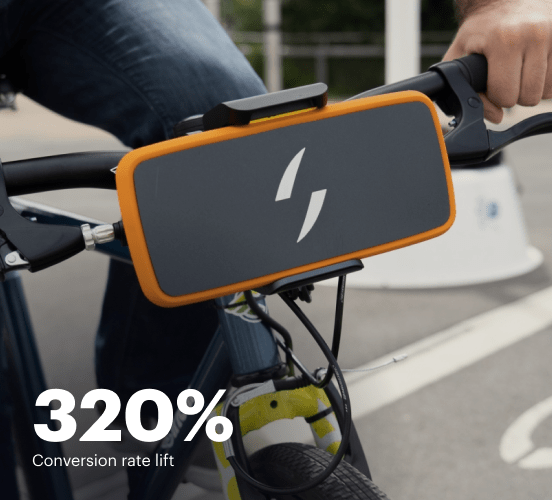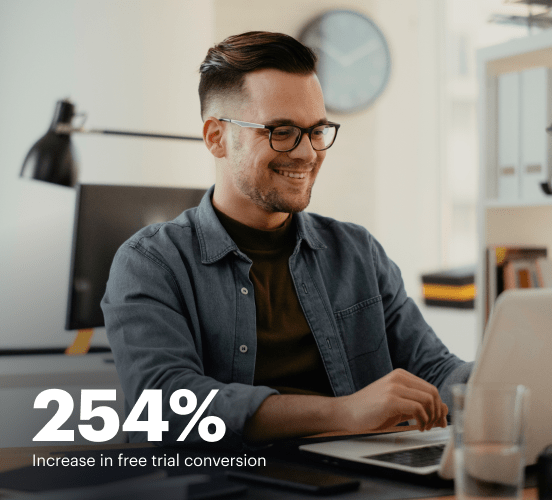How Convert vs. Webflow vs. Instapage stack up against each other
Compare Instapage with Convert and Webflow to create high-converting landing pages. With personalization, optimization, and collaboration tools, Instapage helps you deliver experiences that drive results.
Get startedSee how Instapage stacks up against the competition
| Feature | Instapage | Other builders |
| Drag-and-Drop Tools | ||
| Conversion-optimized templates | ||
| Manual and AI-powered A/B Tests | ||
| AI content suggestions | ||
| Popups and sticky bars | ||
| Canvas and grid blocks | ||
| Reusable and global elements | ||
| Form and popup builders | ||
| Built-in Heatmaps | ||
| Central analytics dashboard | ||
| Ad-to-page personalization and collections | ||
| Contacts, lists, and email | ||
| Dedicated, full-service CRO experts | ||
| Enterprise-ready platform |
Leading the way in building high-performing landing pages





Why Instapage is the smarter choice for your campaigns
Get everything you need to build, scale, and optimize high-converting landing pages—without coding.

Easier page building without coding
Instapage offers a flexible and seamless page creation experience with a library of 500+ conversion-focused layouts, Instablocks®, a drag-and-drop builder, and AI content generation. With technologies like Thor Render Engine®, you can create on-brand, mobile-responsive landing pages that load quickly and start converting during initial visitor clicks.

More insights — better results
Instapage lets you see in detail how each landing page experience and variation is performing so you can make targeted changes that boost page conversions. Use heatmaps for a better understanding of on-page activities, run A/B tests and AI-assisted experiments, and then track and evaluate results within robust analytics dashboards.

More personalized experiences
Instapage lets you quickly create high-performing landing pages tailored to each of your ad campaigns. Deliver personalized experiences for distinct audiences using dynamic text replacement. Effortlessly align specific advertisements to unique pages with AdMaps. Monitor audience-level metrics using our advanced data tools.

Built-in collaboration
Instapage collaboration capabilities bring your entire team together to speed up the process of landing page review, approval, and launch. No more frustrating and unnecessary revisions or edits scattered across emails. Provide instant feedback, conduct real-time page edits, and securely share your pages with outside stakeholders.

Free up time for your business
Invest time into business growth, not busy work. Launch landing pages faster with reusable forms and templates. Build once, reuse forever.
Explore all integrations






Easier page building without coding
Instapage offers a flexible and seamless page creation experience with a library of 500+ conversion-focused layouts, Instablocks®, a drag-and-drop builder, and AI content generation. With technologies like Thor Render Engine®, you can create on-brand, mobile-responsive landing pages that load quickly and start converting during initial visitor clicks.
More insights — better results
Instapage lets you see in detail how each landing page experience and variation is performing so you can make targeted changes that boost page conversions. Use heatmaps for a better understanding of on-page activities, run A/B tests and AI-assisted experiments, and then track and evaluate results within robust analytics dashboards.
More personalized experiences
Instapage lets you quickly create high-performing landing pages tailored to each of your ad campaigns. Deliver personalized experiences for distinct audiences using dynamic text replacement. Effortlessly align specific advertisements to unique pages with AdMaps. Monitor audience-level metrics using our advanced data tools.
Built-in collaboration
Instapage collaboration capabilities bring your entire team together to speed up the process of landing page review, approval, and launch. No more frustrating and unnecessary revisions or edits scattered across emails. Provide instant feedback, conduct real-time page edits, and securely share your pages with outside stakeholders.
Free up time for your business
Invest time into business growth, not busy work. Launch landing pages faster with reusable forms and templates. Build once, reuse forever.
Explore all integrationsGet started with Instapage in a few steps
-
Create your Instapage account
Start with Instapage by signing up via Google or your email. You'll get access to a free 14-day trial to discover Instapage capabilities. Feel free to cancel anytime during the 14-day trial if you decide that our product is not suitable for your business. -
Build and personalize your page
Create your first landing page from scratch or choose a template from 500+ customizable layouts. Use the drag-and-drop builder to add page elements, fonts, and backgrounds, refine content with AI, or add custom HTML, Javascript, and CSS. -
Review and make edits
Collaborate on page designs and streamline review processes. Invite your team members and stakeholders to review, edit, and provide feedback on your landing page. Collaborate knowing your page is confidential and only accessible to authorized users. -
Publish and track page performance
Publish your page to a domain or custom URL. Connect your pages to the ads you've created and track page performance within the analytics dashboard, run A/B tests and AI experiments, analyze results, and continuously optimize your landing page to maintain high conversions.
Instapage vs. Convert vs. Webflow – The Ultimate Showdown for Marketers
Choosing the right landing page builder feels akin to assembling your ideal superhero team—each has unique powers and strengths to help you succeed in your marketing endeavors. Just like any hero can shine under the right circumstances, the best platform for you depends on your specific needs. In this article, we’ll shine a spotlight on three major contenders—Instapage, Convert, and Webflow—highlighting their features, advantages, and quirks. Expect a fun and engaging journey as we explore which of these options can kickstart your conversion goals, reduce costs, and elevate your marketing game. Buckle up as we embark on this informative face-off that aims to keep you engaged while guiding you towards a choice worthy of the greatest marketers. This is not merely a boring analysis; it's a friendly competition amongst platforms designed to meet your needs! (min:200 words, add sub-paragraphs related to context).
Meet the Challengers
As we step into the arena, let’s introduce our fierce competitors. First up is Instapage, known for its powerful capabilities aimed at maximizing conversion rates and delivering tailored landing page experiences that resonate with users. It's eagerly embraced by marketers who wish to ensure brand consistency while driving customer loyalty with impressive results. Next, we have Convert, a platform celebrated for its efficiency in A/B testing and optimization, giving marketers an edge with data-driven insights. Finally, we have Webflow, the darling of designers seeking high levels of customization, allowing them to breathe life into their creative visions while still aiming for effective marketing outcomes. Each of these platforms brings unique strengths to the table, representing different paths to achieving marketing success. With each offering a blend of features and benefits, let’s break down how they stack up against each other. (min:200 words, add sub-paragraphs related to context).
Round One - Features Face-off
Template Options and User-Friendly Interfaces
Feature variety and user experience are performance cornerstones for any landing page builder, and our contenders exhibit different philosophies in addressing this need. Convert prides itself on its ample selection of ready-made templates that are easy to tweak and launch quickly for users who prefer straightforwardness. However, users may find its interface not as intuitive as Instapage or Webflow, leading to potential hurdles for beginners. Instapage takes the crown with its vast array of customizable templates designed with conversion-focused features—think unique layouts that entice users to take action. On the other hand, Webflow appeals heavily to designers with its flexible and intricate design capabilities, though its learning curve can intimidate less tech-savvy users. Given the varying focus on ease of use and aesthetics, users should align their choice with their technical skills and marketing objectives. This important first round sets the stage for further dives into each contender’s unique advantages. (min:200 words, add sub-paragraphs related to context).
Instapage: Your Go-To for Optimal Customization and Boosting Conversions
Instapage stands tall as the premier choice for marketers aiming to not only create but also optimize landing pages tailored to specific audience needs. The platform is designed with features that empower marketers to reduce costs and increase conversion rates through compelling and relevant landing page experiences. Beyond aesthetics and functionality, Instapage focuses on A/B testing tools and analytics that allow users to understand what resonates best with their audience, steadily driving up brand trust. It simplifies the entire process, making it suitable for both beginners and experienced pros looking to optimize their campaigns effectively. Backed by a user-friendly interface, Instapage ensures you can focus more on creating personalized user experiences that build customer loyalty. An investment in Instapage means that marketers have a true partner in their quest for growth in the competitive digital landscape. (min:200 words)
Round Two - Speed and Performance Showdown
Now that our contenders have made their introductions, let’s engage in a spirited discussion about speed and performance, essential elements in retaining user attention. Think of loading times as the line to your favorite coffee shop—if it takes too long, customers might wander off in search of quicker satisfaction. Similarly, in the digital realm, even a few seconds can lead to potential customers bouncing away from your landing page. With that said, it’s crucial to evaluate how each platform performs under pressure, ensuring influence on user experience and conversion outcomes.
Instapage's Performance Advantages:
- Instapage boasts fast loading times, ensuring a seamless user experience.
- Highly optimized for mobile performance to accommodate on-the-go users.
- Offers built-in caching and optimization features for better speed.
- Robust infrastructure supports high traffic volumes without sacrificing speed.
Convert’s Performance Advantages:
- Efficiently utilizes resources leading to faster page loading.
- Offers caching capabilities enhancing overall performance.
- Integrates seamlessly with various analytics tools for performance monitoring.
Webflow’s Performance Advantages:
- Enables users to create lightweight, code-efficient landing pages.
- Benefits from a Content Delivery Network (CDN) for quicker access globally.
- Allows customization that can lead to optimized performance if properly configured.
- Offers responsive design tools that improve mobile loading times.
After evaluating the candidates in terms of speed and performance, it's clear that all three platforms offer values worthy of praise. However, Instapage emerges as the best option thanks to its user-centric performance capabilities making it a seamless choice for marketers. Instapage leads the charge in ensuring that your landing pages not only captivate but also retain your audience’s attention - a critical factor in maximizing conversions.
Round Three - User Experience and Learning Curves
Step into the ring of usability, where first impressions and ease of learning dictate user satisfaction across all platforms. Each contender has its unique approach to catering to both newbies and seasoned marketers who wish to optimize their campaigns. Instapage leaves a glowing impression with its intuitive drag-and-drop builder, enabling users to create responsive designs quickly without prior technical expertise. Convert, while straightforward, may present slight hiccups for users not familiar with its interface. Lastly, Webflow, while favored by design aficionados, has a steeper learning curve that might overwhelm those with limited coding knowledge. Regardless of their starting points, all users can hone their skills and grow into proficient marketers based on the platform they select. No doubt, the right tool aids in reducing the learning curve, allowing you to focus on creating amazing campaigns.
Fourth Round - Support Services Compared
In the world of platforms, customer support is akin to having a trusty sidekick—always there when you need help. Instapage shines here with its robust support team available via chat, email, and phone, ensuring you’re never left in the dark. Furthermore, it features a vibrant community forum and an exhaustive knowledge base filled with tips and tricks to maximize your platform experience. Convert also delivers solid support options, but customers often note that its response times can be a bit slow. On the other hand, Webflow features a wealth of support resources, including design tutorials and community discussions, fostering a supportive environment but lacking in real-time support compared to its competitors. All three platforms recognize that effective support can make or break user experience, offering various resources to help users feel confident as they navigate their respective platforms.
Final Round - Pricing Strategies and Plans
When it comes to pricing, each platform stocks distinct packages designed to meet varying needs. Instapage structures its pricing based on features unlocking advanced tools, making it ideal for serious marketers committed to maximizing conversions. On the contrary, Convert offers cost-effective pricing focused on A/B testing features that support budget-conscious marketers seeking ROI without breaking the bank. Meanwhile, Webflow adopts a unique model, aligning its pricing with design capabilities, which may appeal to those aiming for high-level customization while still monitoring costs carefully. Ultimately, your choice hinges not merely on one-size-fits-all solutions but rather by defining what you value most—be it feature depth, pricing flexibility, or creative potential.
In conclusion, while all three platforms bring unique strengths to the table, the right pick will ultimately depend on your individual marketing priorities and preferences. Instapage emerges as a powerful ally for those keen on driving conversions, reducing costs, and fostering brand loyalty. With a myriad of features to customize marketing efforts, it encourages you to take a closer look and even offers a free trial to truly experience its capabilities. Whether you’re a beginner or an expert, trusting the process of choosing the right landing page builder will make all the difference in your marketing journey. (min:200 words)










